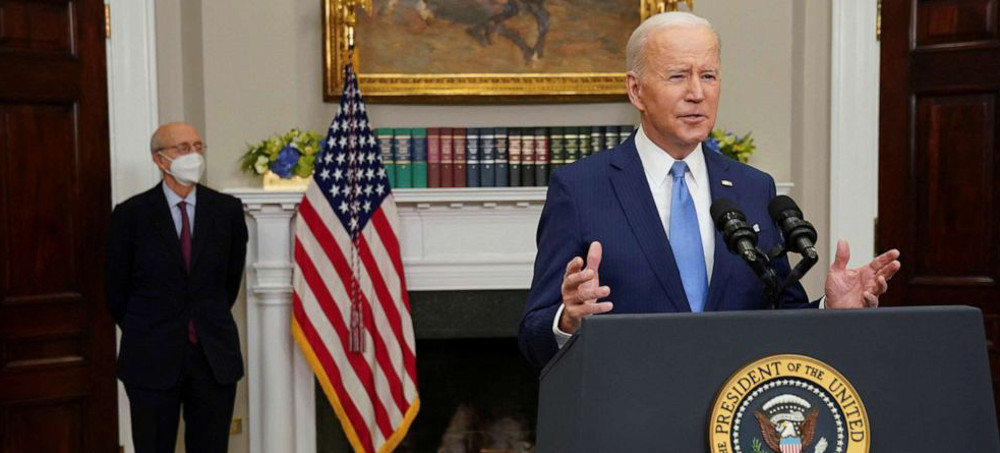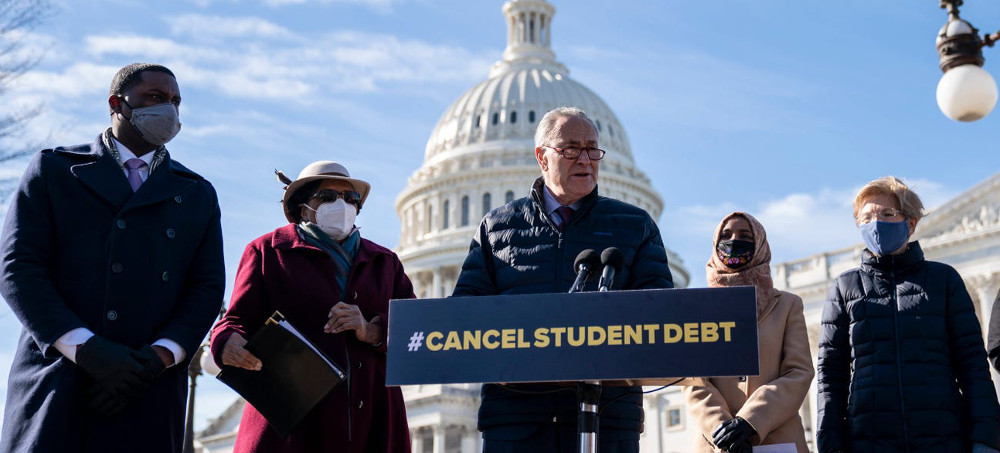Live on the homepage now!
Reader Supported News
The leader of a coup in Burkina Faso is the latest in a line of U.S.-trained soldiers who overturned civilian leaders.
The coup was announced on state television Monday by a young officer who said the military had suspended the constitution and dissolved the government. Beside him sat a camouflage-clad man whom he introduced as Burkina Faso’s new leader: Lt. Col. Paul-Henri Sandaogo Damiba, the commander of one of the country’s three military regions.
Damiba is a highly trained soldier, thanks in no small part to the U.S. military, which has a long record of training soldiers in Africa who go on to stage coups. Damiba, it turns out, participated in at least a half-dozen U.S. training exercises, according to U.S. Africa Command, or AFRICOM.
In 2010 and 2020, he participated in an annual special operations training program known as the Flintlock exercise. In 2013, Damiba was accepted into an Africa Contingency Operations Training and Assistance course, which is a State Department-funded peacekeeping training program. In 2013 and 2014, Damiba attended the U.S.-sponsored Military Intelligence Basic Officer Course-Africa. And in 2018 and 2019, he participated in engagements with a U.S. Defense Department Civil Military Support Element in Burkina Faso.
Damiba is just the latest in a carousel of coup leaders in West Africa trained by the U.S. military as the U.S. has pumped in more than $1 billion in security assistance to promote “stability” in the region. Since 2008, U.S.-trained officers have attempted at least nine coups (and succeeded in at least eight) across five West African countries, including Burkina Faso (three times), Guinea, Mali (three times), Mauritania, and the Gambia.
Since the 2000s, the United States has regularly deployed small teams of commandos to advise, assist, and accompany local forces, even into battle; provided weapons, equipment, and aircraft; offered many forms of training, including Flintlock, which is conducted by Special Operations Command Africa and focused on enhancing the counterterrorism capabilities of nations in West Africa, including Burkina Faso, Guinea, Mali, Mauritania, Niger, Nigeria, and Senegal.
“When the U.S. prioritizes tactical training, we overlook longer-term goals that could create more stable governments,” said Lauren Woods, director of the Security Assistance Monitor, which is a program of the nonprofit Center for International Policy. “We need more transparency and public debate on the foreign military training that we provide. And we need to do a much better job thinking about the long-term risks — including coups and abuses by forces we train.”
AFRICOM emphasizes that its security cooperation and “capacity-building activities” foster the “development of professional militaries,” which are disciplined and committed to the well-being of their citizens. “U.S. military training regularly includes modules on the law of armed conflict, subjugation to civilian control, and respect for human rights,” AFRICOM spokesperson Kelly Cahalan told The Intercept. “Military seizures of power are inconsistent with U.S. military training and education.”
But coups d’état by U.S.-trained officers have become an increasingly common occurrence in Burkina Faso and elsewhere in the region.
Last summer, for example, American Green Berets arrived in Guinea to train a special forces unit led by Col. Mamady Doumbouya, a charismatic young officer who had also served in the French Foreign Legion. In September, members of Doumbouya’s unit took time out from their ongoing instruction — in small unit tactics, tactical combat casualty care, and the law of armed conflict — to storm the presidential palace and depose the country’s 83-year-old president, Alpha Condé. Doumbouya soon declared himself Guinea’s new leader and the U.S. ended the training.
In 2020, Col. Assimi Goïta, who worked with U.S. Special Operations forces for years, participating in Flintlock training exercises and attending a Joint Special Operations University seminar at MacDill Air Force Base in Florida, headed the junta that overthrew Mali’s government.
“The act of mutiny in Mali is strongly condemned and inconsistent with U.S. military training and education,” Marine Corps Lt. Col. Anton T. Semelroth, a Pentagon spokesperson, said at the time.
After staging the coup, Goïta stepped down and took the job of vice president in a transitional government tasked with returning Mali to civilian rule. But nine months later, he seized power again in his second coup.
Goïta wasn’t even the first U.S.-trained Malian officer to overthrow the country’s government. In 2011, when a U.S.-backed uprising in Libya toppled autocrat Muammar Gaddafi, Tuareg fighters in his service looted the regime’s weapons caches, traveled to their native Mali and began to take over the northern part of that country. Angered by the ineffective response of his government, Amadou Sanogo — an officer who learned English in Texas, received intelligence training in Arizona, and underwent Army infantry-officer basic training in Georgia — took matters into his own hands and overthrew his country’s democratically elected government.
“America is a great country with a fantastic army,” he said after the 2012 coup. “I tried to put all the things I learned there into practice here.”
In 2014, another U.S.-trained officer, Lt. Col. Isaac Zida, seized power in Burkina Faso amid popular protests. Two years earlier, when he was a major, Zida attended a counterterrorism training course at MacDill Air Force Base that was sponsored by Joint Special Operations University and attended a military intelligence course in Botswana that was financed by the U.S. government.
The next year, another coup in Burkina Faso installed Gen. Gilbert Diendéré. Diendéré had not only taken part in a U.S.-led Flintlock counterterrorism exercise, but he also served as a literal advertisement for it, appearing in an AFRICOM photo addressing Burkinabe soldiers before their deployment to Mali in support of the 2010 Flintlock exercise.
In 2014, two generations of U.S.-educated officers faced off in the Gambia as a group of American-trained would-be coup-makers attempted (but failed) to overthrow another U.S.-trained coup-maker, Yahya Jammeh who had seized power back in 1994. The unsuccessful rebellion claimed the life of Lamin Sanneh, the purported ringleader, who had earned a master’s degree at National Defense University in Washington, D.C.
“I can’t shake the feeling that his education in the United States somehow influenced his actions,” wrote Sanneh’s former NDU mentor Jeffrey Meiser. “I can’t help but wonder if simply imprinting our foreign students with the ‘American program’ is counterproductive and unethical.”
In 2008, Stars and Stripes reported that Gen. Mohamed Ould Abdel Aziz, the leader of a coup against Mauritania’s elected president, “has worked with U.S. forces that train in the African country.” Arrested and charged with corruption after a decadelong rule, Aziz was recently released on bail due to ill health.
U.S.-trained coup-plotters aren’t strictly confined to West Africa. Before Abdel-Fattah el-Sissi deposed Egypt’s first democratically elected president, Mohammed Morsi, he underwent basic training at Fort Benning, Georgia, (in 1981) and advanced instruction at the U.S. Army War College (in 2006).
A 2018 study by the military’s go-to think tank, the Rand Corporation, cast doubt on the notion that U.S. military training breeds coup-makers.
“[T]here is little evidence that overall [security sector assistance] (measured in dollar terms) associates with coup propensity in Africa,” according to the study, which was written for the Office of the Secretary of Defense and did note that there was a “marginally significant” association in the post-Cold War period.
A year before, however, a study by Jonathan Caverley of the U.S. Naval War College and Jesse Savage of Trinity College Dublin in the Journal of Peace Research, analyzing data from 1970 to 2009, found “a robust relationship between U.S. training of foreign militaries and military-backed coup attempts” despite the authors limiting their analysis to the International Military Education and Training program — “which explicitly focuses on promoting norms of civilian control.”
 An oil drilling platform seen from Port Aransas, Texas. (photo: Eric Gay/AP)
An oil drilling platform seen from Port Aransas, Texas. (photo: Eric Gay/AP)
The decision by the United States District Court for the District of Columbia is a major victory for environmental groups that criticized the Biden administration for holding the sale after promising to move the country away from fossil fuels. It had been the largest lease sale in United States history.
Now the Interior Department must conduct a new environmental analysis that accounts for the greenhouse gas emissions that would result from the eventual development and production of the leases. After that, the agency will have to decide whether it will hold a new auction.
“This is huge,” said Brettny Hardy, a senior attorney for Earthjustice, one of several environmental groups that brought the lawsuit.
“This requires the bureau to go back to the drawing board and actually consider the climate costs before it offers these leases for sale, and that’s really significant,” Ms. Hardy said, adding, “Once these leases are issued, there’s development that’s potentially locked in for decades to come that is going to hurt our global climate.”
Melissa Schwartz, a spokeswoman for the Interior Department, said the agency was reviewing the decision.
As a candidate, Mr. Biden promised to stop issuing new leases for drilling on public lands and in federal waters. “And by the way, no more drilling on federal lands, period. Period, period, period,” Mr. Biden told voters in New Hampshire in February 2020. Shortly after taking office, he signed an executive order to pause the issuing of new leases.
But a federal judge in Louisiana blocked that order, and also ruled that the administration must hold lease sales in the Gulf that had already been scheduled.
Biden administration officials have said Interior Secretary Deb Haaland risked being held in contempt of court if the auction was not held. Environmental groups, however, argued that the administration had other options, including doing a new analysis to examine the ways that the burning of oil extracted from the Gulf would contribute to climate change.
The lawsuit alleged that the Interior Department relied on an outdated environmental analysis conducted by the Trump administration that concluded additional drilling in the Gulf would not increase greenhouse gas emissions. The environmental groups said that analysis did not consider new information about the impact of offshore drilling on rising global temperatures.
Hitting a wall. With the Build Back Better Act hitting a wall in Congress, some Democrats want to forge ahead with a stand-alone climate bill. But their solution could mean abandoning other parts of President Biden’s agenda.
Scott Lauermann, a spokesman for the American Petroleum Institute, which represents oil and gas companies, said in a statement, “We are reviewing this disappointing decision and considering our options. Offshore energy development plays a critical role in strengthening our nation’s economy and energy security.”
Companies had argued to the court that vacating the lease sale would compromise the confidential bids that were submitted for the tracts, making their competitors aware of who was bidding on what, and for how much.
Shell, BP, Chevron and Exxon Mobil offered $192 million for the rights to drill in the area offered by the government. Though the sale occurred on Nov. 17, the leases have not yet been issued.
Judge Rudolph Contreras said in his ruling that the Interior Department “acted arbitrarily and capriciously in excluding foreign consumption from their greenhouse gas emissions” and that it was required to do so under the 1970 National Environmental Policy Act, or NEPA, which says the government must consider ecological damage when deciding whether to permit drilling and construction projects.
Any disruption that revoking the lease sales might cause, he wrote, “do not outweigh the seriousness of the NEPA error in this case and the need for the agency to get it right.”
 An employee pulls a cart at Amazon's JFK8 distribution center in Staten Island, New York, U.S., November 25, 2020. (photo: AP)
An employee pulls a cart at Amazon's JFK8 distribution center in Staten Island, New York, U.S., November 25, 2020. (photo: AP)
ALSO SEE: Amazon Is Addicted to Union-Busting
The complaint, first reported by Bloomberg News, marks the National Labor Relations Board’s latest brush with the e-commerce giant over questions about its tactics. The NLRB wants to compel Amazon to take certain actions to inform workers of their right to organize, according to Kathy Drew King, a regional director for the agency.
Amazon “repeatedly broke the law by threatening, surveilling, and interrogating their Staten Island warehouse workers who are engaged in a union organizing campaign,” King said in a statement.
Amazon spokeswoman Kelly Nantel said the allegations were false, adding without elaboration that “we look forward to showing that through this process.”
(Amazon founder Jeff Bezos owns The Washington Post.)
The complaint comes as a separate, high-stakes unionization effort is playing out in Alabama, where Amazon workers in Bessemer are poised to vote. Workers there overwhelmingly rejected a union last year, but the NLRB called for a revote after finding that Amazon improperly interfered in that election. An NLRB official specifically cited Amazon’s efforts to place an unmarked U.S. Postal Service mailbox in front of the warehouse just after voting started, writing that Amazon “essentially [hijacked] the process and gave a strong impression that it controlled the process.”
It also coincides with a surge in labor activism across the country; dozens of strikes and strike authorizations have flared up in recent months — including at Kellogg’s and John Deere.
The Amazon Labor Union, an independent group of workers that isn’t connected to a major national union, recently collected the required signatures to hold a vote on Staten Island, an NLRB spokesperson said Wednesday. A hearing on the vote is scheduled for Feb. 16.
The NLRB complaint stems from four recent cases, the earliest of which was filed in May 2021, according to a legal document obtained by The Washington Post. It alleges the company threatened workers against unionizing, surveilled them in their activities and tried to solicit grievances in exchange for voting against the union. It names two human resources managers, one operations manager, two security guards and a consultant of acting on Amazon’s behalf to violate workers’ rights.
According to the complaint, the consultant “interrogated” employees about their organizing activities, called union organizers “thugs” and allegedly threatened employees by telling them it would be futile to select the union as their bargaining representative. The consultant also is accused of soliciting unspecified grievances from employees with the promise to remedy them if they reject the union.
Regulators also describe attempts to confiscate “union literature” and prevent employees from distributing it in break rooms. One of the security guards is alleged to have taken union literature and told employees not to distribute it, while a human resource assistant is accused of ordering employees to remove it from the break room.
The complaint contends Amazon has been “interfering with, restraining and coercing employees” who are exercising their rights under the law.
It seeks to require Amazon supervisors to undergo mandatory training describing employees’ rights under the National Labor Relations Act. It also seeks to require the company to post notices describing workers rights on social media, in its electronic applications for workers, and in all employee bathrooms including in the stalls.
The NLRB has set a hearing on the matter for April 5 and has given Amazon until Feb. 10 to respond to the complaint.
 President Joe Biden delivers remarks with Supreme Court Justice Stephen Breyer as they announce Breyer will retire at the end of the court's current term, at the White House in Washington, D.C., Jan. 26, 2022. (photo: Kevin Lamarque/Reuters)
President Joe Biden delivers remarks with Supreme Court Justice Stephen Breyer as they announce Breyer will retire at the end of the court's current term, at the White House in Washington, D.C., Jan. 26, 2022. (photo: Kevin Lamarque/Reuters)
US president announced plans for court at White House event marking retirement of Justice Stephen Breyer
Lauding the retiring justice as a “beacon of wisdom” and a “model public servant at a time of great division in this country”, Biden pledged to replace him with someone worthy of Breyer’s “legacy of excellence and decency”. He said the nominee would have “extraordinary qualifications, character, experience and integrity, and that person will be the first Black woman ever nominated to the United States supreme court.”
He added: “It is long overdue in my view.”
Biden’s confirmation that he is still studying the résumés of candidates and has yet to make his pick will do little to settle nerves among progressives still smarting from Donald Trump’s three supreme court appointments. Many Democrats want the president to emulate the warp speed with which the Trump administration drove through the confirmation of Amy Coney Barrett in less than six weeks following Ruth Bader Ginsburg’s death in September 2020.
The Washington Post, citing an anonymous source, said that the majority leader in the Senate, Chuck Schumer, is aiming for a similar timeline.
Replacing Breyer with a like-minded justice is seen by many Democrats as critical in preserving the already beleaguered rump of liberals on the bench. The retiring justice is one of only three such individuals on the nine-justice court, and they are so outnumbered that the country now faces drastic changes in several key areas from abortion to guns and affirmative action.
Despite the pressure for haste among his party’s members, Biden insisted that he would be “rigorous” in choosing the nominee. He would listen to advice from senators and meet candidates, indicating a selection process that is likely to take weeks not days.
For his part, Justice Breyer is hoping that his successor can be confirmed and in place within the next six months. In his formal retirement letter to Biden, he said he would step down at the start of the court’s summer recess in June or July, “assuming that by then my successor has been nominated and confirmed”.
Speaking in the Roosevelt Room of the White House, Breyer made a lyrical paean to American unity. Recalling a speech he likes to deliver to school students, he said that the US was an experiment that is still going on.
“My children and grandchildren will determine whether the experiment will last, and as an optimist I’m pretty sure that it will,” he said.
Biden first committed himself to promoting a Black woman to the nation’s highest court at a presidential debate against Trump during the 2020 presidential campaign. The promise was reportedly made after intense prodding by the prominent South Carolina Democrat Jim Clyburn, who endorsed Biden the following day in a move that helped propel him into the White House.
Though the race is now on to confirm Breyer’s replacement before the court’s term reaches its summer recess, there are large hurdles ahead. Looming over the proceedings is the evenly divided 50-50 split in the US Senate, the chamber that will preside over the confirmation hearings of whomsoever Biden picks.
The Democrats hold the casting vote with Vice-President Kamala Harris, but they will need to keep all 50 senators on board during the process. That is a challenge that has eluded the Biden administration in recent months with the high-profile defections of Joe Manchin and Kyrsten Sinema over vital issues ranging from the president’s Build Back Better legislation to overcoming the filibuster to secure essential voting rights reforms.
To reduce any risk of Democratic splits, Schumer will also be looking to lure Republican moderates such as Susan Collins from Maine and Lisa Murkowski from Alaska to their side.
Then there are the nationwide midterm elections in November which will inevitably place a partisan political pall over the confirmation process. Republicans have already begun to test out lines of attack, predicting that Biden’s nominee will be, in the words of the senator from Florida Rick Scott, “a radical liberal with extremist views”.
Rightwing Twitter feeds have also lit up with claims that Biden’s choice of a Black woman would constitute unlawful sex and race discrimination. Those playing the affirmative-action card were forgetting that in 1980 Ronald Reagan pledged to pick the first woman to sit on the nation’s highest court, appointing Sandra Day O’Connor the following year.
Republican leaders will be hoping that by portraying Biden’s choice as a culture wars threat to American values they will help to drive out the party’s base to the polling booths on 8 November.
Similar calculations will be at play on the Democratic side. Party strategists will want to leverage the nomination of a Black woman as an energizing factor at the polls for important elements of its electorate who include African Americans, women and progressive voters.
 Senate Majority Leader Chuck Schumer (center) speaking at a press conference about student debt outside the Capitol on February 4 in Washington, D.C. (photo: Drew Angerer/Getty)
Senate Majority Leader Chuck Schumer (center) speaking at a press conference about student debt outside the Capitol on February 4 in Washington, D.C. (photo: Drew Angerer/Getty)
On Wednesday, Sens. Elizabeth Warren and Chuck Schumer, along with Reps. Pramila Jayapal, Ayanna Pressley, Ilhan Omar, and Katie Porter, led 79 of their Democratic colleagues in demanding that Biden release the memo outlining his legal ability to cancel federal student debt broadly and "immediately" cancel up to $50,000 in student debt per borrower.
"Publicly releasing the memo outlining your existing authority on cancelling student debt and broadly doing so is crucial to making a meaningful difference in the lives of current students, borrowers, and families," the lawmakers wrote. "It has been widely reported that the Department of Education has had this memo since April 5, 2020 after being directed to draft it."
Ron Klain, the White House chief of staff, told Politico last April that Biden had asked Education Secretary Miguel Cardona to create a memo on the president's legal authority to forgive $50,000 in student loans per person. As Insider reported in November, redacted documents obtained by the Debt Collective, the nation's first debtors union, indicated that the memo has existed since April 5, and White House officials have seen its contents but haven't made them public.
But even before those documents were disclosed, Democrats were calling for the release of the memo to give 43 million federal student-loan borrowers needed relief. In October, Minnesota Rep. Ilhan Omar gave the Education Department two weeks to release the memo, but that deadline came and went with no response.
"Millions of borrowers across the country are desperately asking for student-debt relief," Omar told Insider at the time. "We know the president can do it with the stroke of a pen. We were told over six months ago that they were just waiting on a memo to determine whether they would give relief, and weeks since we sent a letter asking them to do so. Release the memo. Cancel student debt."
New Jersey Sen. Bob Menendez said during a roundtable on Wednesday that "it would be good to be publicly known" whether Biden has the legal authority to cancel student debt.
"I have not read the memo, but it is my view that the memo should ultimately certify that the president has the authority to do exactly what we're advocating for," Menendez said.
Beyond the release of the memo, the push for broad student-loan forgiveness continues to amplify. As Warren previously told Insider, her proposal to cancel $50,000 in student loans per borrower would completely eliminate debt for 36 million people, or 84% of all federal borrowers.
"This is the single most effective executive action President Biden could take to jump-start our economy and begin to narrow the racial wealth gap," she said.
While Biden promised during his campaign to approve $10,000 in student-loan forgiveness per borrower, he has remained largely silent on that promise since taking office. Jen Psaki, the White House press secretary, recently said Biden would sign a bill passed by Congress to cancel student debt, but his promise to do so "immediately" remains unfulfilled. He even ignored a question on that promise during his first solo press conference of the year.
Still, while Biden extended the pause on student-loan payments through May 1, giving borrowers an additional 90 days of relief, lawmakers want to ensure that millions of Americans won't be stuck with monthly bills they can't afford.
They wrote that "eliminating debt before the pause ends is a commonsense step so that millions of borrowers have more breathing room in their family budgets and our national economy is not further held back."
 A U.S. drone strike that was supposed to target ISIS-K suicide bombers instead killed 10 civilians in Kabul, Afghanistan, in August. (photo: Marcus Yam/Getty)
A U.S. drone strike that was supposed to target ISIS-K suicide bombers instead killed 10 civilians in Kabul, Afghanistan, in August. (photo: Marcus Yam/Getty)
Lloyd Austin issued the directive months after the Pentagon admitted that a U.S. drone attack in Afghanistan in August had mistakenly killed 10 civilians, including 7 children.
In a two-page memo, Austin ordered senior civilian and military officials to send an "action plan" to his desk within 90 days.
"The protection of civilians is fundamentally consistent with the effective, efficient, and decisive use of force in pursuit of U.S. national interests, and our efforts to mitigate and respond to civilian harm are a direct reflection of U.S. values," Austin wrote in the directive.
Austin issued the order after intense criticism of a U.S. airstrike in Kabul, Afghanistan, on Aug. 29. The drone strike, meant to target terrorists, mistakenly killed 10 civilians, including seven children, Pentagon officials admitted in September.
"We now assess it is unlikely that the vehicle and those who died were associated with ISIS-K," Gen. Kenneth McKenzie, the head of U.S. Central Command, said in September, referring to the Islamic State terrorist groups' affiliate in Afghanistan. "It was a mistake."
Austin's directive came the same day the Rand Corp., a federally funded think tank, released a report that found "considerable weaknesses" in the process the Pentagon uses to assess the deaths and injuries of innocent people.
The military's internal reporting on civilian casualties is not always reliable or complete, and reports of civilian deaths often appear to be dismissed, the Rand report found.
"Civilian casualties were alleged to have occurred, the military indeed attacked the alleged location, and available military information neither confirmed nor ruled out civilian casualties. Thus, these cases were determined to be not credible."
The report also found that U.S. intelligence efforts focus too heavily on enemy combatants, limiting the resources available to "understand the broader civilian picture."
"Without reliable operational data that are easily accessible to commanders, the military will be limited in its ability to understand the root causes of civilian casualties, characterize patterns of harm, and identify specific measures to mitigate civilian harm while preserving mission-effectiveness and force protection,” the report said.
Defense Department spokesman John F. Kirby told reporters Thursday that Austin is familiar with the issue of civilian deaths from his time as a ground commander in Iraq and Afghanistan, and that the steps he outlined in the memo were “informed by recent studies, independent as well as department reviews,” including the Rand assessment.
Kirby added that Austin’s goals were also shaped by “recent press reporting” on civilian casualties.
 Members of the Wiyot Tribe paddle a dugout redwood canoe from Indian Island. (photo: AP)
Members of the Wiyot Tribe paddle a dugout redwood canoe from Indian Island. (photo: AP)
ALSO SEE: California Museum Returns Massacre Remains
to Wiyot Tribe
Save the Redwoods League planned to announce Tuesday that it is transferring more than 500 acres (202 hectares) on the Lost Coast to the InterTribal Sinkyone Wilderness Council.
The group of 10 tribes that have inhabited the area for thousands of years will be responsible for protecting the land dubbed Tc’ih-Léh-Dûñ, or “Fish Run Place,” in the Sinkyone language.
Priscilla Hunter, chairwoman of the Sinkyone Council, said it’s fitting they will be caretakers of the land where her people were removed or forced to flee before the forest was largely stripped for timber.
“It’s a real blessing,” said Hunter, of the Coyote Valley Band of Pomo Indians. “It’s like a healing for our ancestors. I know our ancestors are happy. This was given to us to protect.”
The transfer marks a step in the growing Land Back movement to return Indigenous homelands to the descendants of those who lived there for millennia before European settlers arrived.
The league first worked with the Sinkyone council when it transferred a 164-acre (66-hectare) plot nearby to the group in 2012.
The league recently paid $37 million for a scenic 5-mile (8-kilometer) stretch of the rugged and forbidding Lost Coast from a lumber company to protect it from logging and eventually open it up to the public.
Opening access to the public is not a priority on the property being transferred to the tribal group because it is so remote, said Sam Hodder, president and CEO of the league. But it serves an important puzzle piece wedged between other protected areas.
Steep hills rise and fall to a tributary of the Eel River that has steelhead trout and Coho salmon. The property was last logged about 30 years ago and still has a large number of old-growth redwoods, as well as second-growth trees.
“This is a property where you can almost tangibly feel that it is healing, that it is recovering,” Hodder said. “You walk through the forest and, even as you see the kind of ghostly stumps of ancient trees that were harvested, you could also in the foggy landscape see the monsters that were left behind as well as the young redwoods that are sprouting from those stumps.”
The league purchased the land two years ago for $3.5 million funded by Pacific Gas … Electric Co. to provide habitat for endangered northern spotted owl and marbled murrelet to mitigate other environmental damage by the utility.
PG…E was set to emerge Tuesday from five years of criminal probation for a 2010 explosion triggered by its natural gas lines that blew up a San Bruno neighborhood and killed eight people. It's been blamed since 2017 for sparking more than 30 wildfires that wiped out more than 23,000 homes and businesses and killed more than 100 people.
In an effort to reduce its liability and the chance of vegetation contacting power lines and sparking fires, PG…E has been criticized for destroying many large and old trees.
“Thanks to Save the Redwoods League for seizing on any opportunity to protect lands on the Lost Coast that are vital to its conservation,” said Michael Evenson, vice president of the Lost Coast League, which advocates for protecting water and wildlife in the area. “But PG…E getting a green merit badge after all the destruction they’re doing ... is not palatable.”
Hawk Rosales, former executive director of the council, said the new property adds a significant holding to the 4,000 acres (1,618.7 hectares) the group protects for cultural and ecological purposes.
More importantly, it recognizes the tribal group’s importance in caring for lands.
“For so many decades tribal voices have been marginalized in the mainstream conservation movement,” Rosales said. “It’s only until very recently that they have been invited to participate meaningfully and to take a leadership role.”
Hodder said the league was trying to remove barriers and increase the scale of land managed by tribal communities and return Indigenous knowledge and practices, such as setting small controlled fires to clear out undergrowth that lead to healthier forests.
“These communities have been stewarding these lands across thousands of years," Hodder said. “It was the exclusion of that stewardship in many ways that’s gotten us into the mess that we’re in.”
Follow us on facebook and twitter!
PO Box 2043 / Citrus Heights, CA 95611



No comments:
Post a Comment